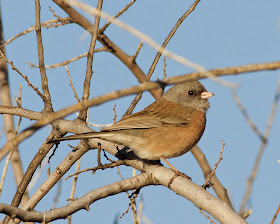This past Saturday, I was free to go birding by myself and decided that Mt Ord in Maricopa County was a prime spot for FOS (first of the season) migrants. As I have mentioned in past posts, this is probably my favorite place to go birding in Maricopa County and once again it did not disappoint.
I set my sights on the top of the mountain first and headed directly to the top. I quickly discovered that Blue-gray Gnatcatchers had returned with a vengeance and was probably the most numerous species of bird that I found over the entire mountain. They were very vocal and singing and at one time I had 5 of them in the same area, out-dueling each other for territory rights.
Blue-gray Gnatcatcher
Blue-gray Gnatcatcher
Blue-gray Gnatcatcher
The second most numerous bird was the Bewick's Wren, however they were a bit less photogenic that the gnatcatchers, but I have to include at least one photo of one for comparison with a House Wren that was also located along the way.
Bewick's Wren
House Wren
The irruption of the Cassin's Finch this year was still evident in the upper elevations including this male and female.
Cassin's Finch - Male and Female
At the top, I had a female Hairy Woodpecker pose long enough in the sunlight for a photo or two. It is always strange to have this bird show up as a 'rare' bird in eBird when I complete my list. But eBird has factors built in to prevent rarities being added without some kind of backup and this bird is definitely rare in the rest of the county. This is the only area in the county where they are regularly seen.
Hairy Woodpecker - Female
Violet-green Swallows had also returned which is always nice to see and since I had a nice blue sky background to work with, I attempted to photograph one in flight. Not easy to do if you are aware of the erratic flight pattern of these birds. But the photo does help to show how this species got its name with its violet rum patch and green head and back.
Violet-green Swallow
Violet-green Swallow
The highlight at the top of the mountain was my FOS Painted Redstart. Such a colorful bird and a regular summer breeder in Arizona and New Mexico.
Painted Redstart
Painted Redstart
One final bird at the top as I reached my vehicle and was getting ready to head back down the mountain, was the Juniper Titmouse and this one appeared to be feasting on some tree buds.
Juniper Titmouse
Juniper Titmouse
I descended back down from the top to the 1688 Trailhead and headed out along this trail that runs along the west side of the Mt Ord but at an elevation that is considerably lower than the summit. I covers quite the convergence zone of pine forests and the lower scrub oak habitat lower down. Spotted Towhees and Black-chinned Sparrows were in abundance along this road. One of the Black-chinned Sparrows gave me probably my best ever photos of this species. And one can never get enough photos of the vibrant Spotted Towhee.
Black-chinned Sparrow
Black-chinned Sparrow
Black-chinned Sparrow
Spotted Towhee
Spotted Towhee
Want some scenery photos of this magnificent place? Then here are some various photos of the surrounding areas.
Mazatzal Mountains to the west with Beeline Hwy in the lower foreground.
Bartlett Lake to the west.
Roosevelt Lake to the south and east.
Four Peaks to the south
Mazatzal Mountains to the west.
Mogollon Rim in the distance on the horizon to the north.
Manzanita flower buds
More Manzanita flower buds
Looking west again, with the bridge and Beeline Hwy to the lower left. The smaller yellowish road on the closest ridge is the rock and dirt road one has to traverse to get up the mountain.
Mazatzal Mountains to the north and west.




























































